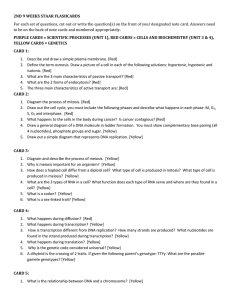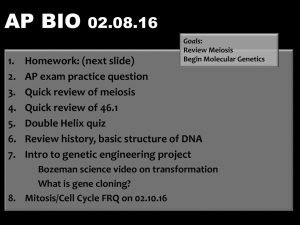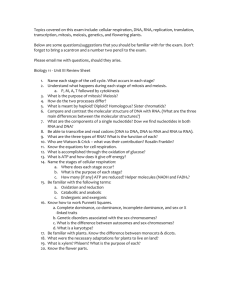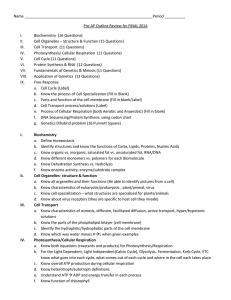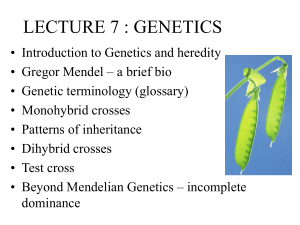Biology EOC Review 2012
advertisement
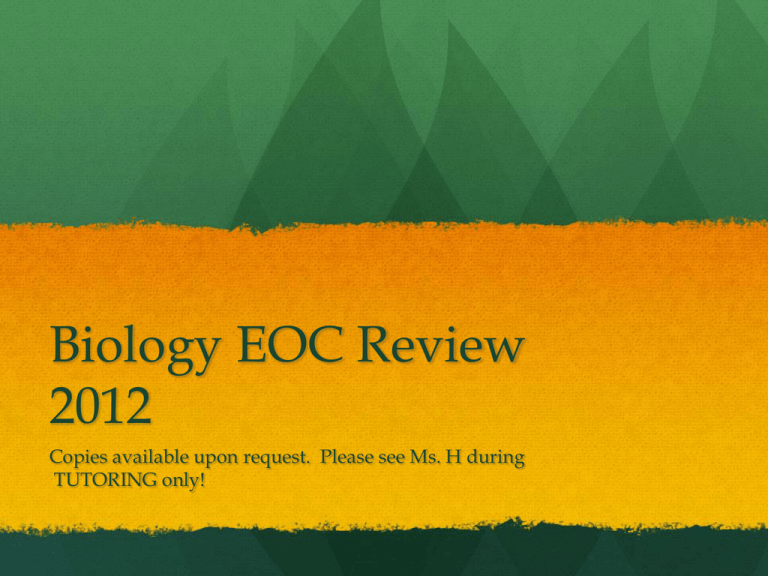
Biology EOC Review 2012 Copies available upon request. Please see Ms. H during TUTORING only! About the EOC Required for graduation 15 percent rule is still up for debate You STILL have to pass, or you won’t graduate! Biology EOC has 54 Multiple Choice Questions You have 4 hours Don’t rush! Take the time to actually READ the material! Scores won’t come out until school is done. Study Strategies Identify strengths and weaknesses Try to improve your weakest areas, but don’t neglect the other areas! Don’t just “look at” your notes! Interact with the information Find practice problems Rephrase notes in your own words Explain a concept to someone else Study Strategies DON’T just blindly copy someone to get the practice problems done. YOU are responsible for the information. Are you really going to let someone else think for you and cripple you on test day because you never learned to think? Come to tutoring! If you don’t understand something or can’t explain it in gorey detail, GET HELP! Study Strategies Form a study group- actually study! Keep it small, be selective of who you study with Divide and conquer- if pressed for time, try to have someone in your group each tackle a particular unit or topic, have them explain it to the group. Meet regularly to discuss the material, but don’t over do it Get a good night’s sleep and eat well (eat a real meal, not chips, candy, and a soda) Make a flash card of things you know you tend to forget. Tape it to your bathroom mirror and recite the things on your flash card every day while you get ready for school. Test Taking Strategies Test taking strategies Process of elimination If you can narrow a question down to two possible choices, you’ve increased your odds of guessing correctly by 50% ! If you don’t know a question, SKIP IT and come back later Don’t leave things blank, but make sure you give yourself enough time to answer the questions you do know where you can earn points. Breathe! Breakdown words you don’t know. We’ve talked about prefixes and suffixes all year long Physically cover distracting information with scratch paper or your hand. Test Taking Strategies If you find yourself glazing over, put your pencil down, close your eyes and take a few deep breaths. Sit up straight and try again. DON’T sleep! Take your time! You have four hours to answer 54 questions. That’s a little less than twice the questions we normally give you on an exam. Sit up! You’ll increase the flow of oxygen to your brain and increase your chances of understanding the stuff you’re reading Test Taking Strategies Write in your booklets! Don’t be afraid to take notes, hi-lite, or underline important words Draw diagrams if it helps you break down a problem. Identify what the problem is asking for. Sometimes you will be given a lot of information! It helps to know what you’re looking for in a problem. Test Taking Strategies You are NOT penalized for guessing (unless you guess on the whole test…) Make your best guess if you do not know! Use information from previous problems Sometimes you can find answers to other problems on the test just by answering a different question that might jog your memory Plan something fun to do after the EOC- see a movie, get some ice cream, visit a friend, etc. Don’t party too hard! You’ve got other exams to think about! Unit 1: Safety and Scientific Method Unit 1 : Safety & Scientific Method MSDS- material safety data sheet Dangers/ precautions to take/ action to take Hazard Diamond (NFPA Safety Diamond) Flammability Hazard Stability/Reactivity Hazard Special or Specific Hazard Health Hazards Rated 0- 4, (least to most dangerous) Unit 1: Safety/Scientific Method Scientific Method: Observe Question Research Hypothesis Collect Data/ Do experiment Draw conclusions Unit 1: Safety/Scientific Method Experimental Design Control Controlled experiment Dependent Variable Independent Variable Draw Conclusions Replication Accuracy Vs. Precision Theory Vs. Hypothesis Vs. Law Unit 2: Biochemistry Unit 2: biochemistry Macromolecules – smaller molecules form larger ones Carbohydrates (Short term energy) Starches, sugars Monosaccharide -Ose means sugar Lipids (long term energy) glycerol, waxes, steroids, fats, phospholipids Glycerol Proteins (building block, enzymes) (Amino Acids) -Ase means enzyme Nucleic Acids (DNA/RNA) (Nucleotides) Unit 2: biochemistry Enzymes are proteins that act as catalysts Lock and Key mechanism Enzyme fits onto substrate at active site Things that affect enzyme activity: Temperature (Too high- denatures (kills), too cold (slow)) pH- optimal range Salts (can denature protein) Inhibitors Competitive- block active site allosteric- change shape of active site to prevent binding. Unit 2: biochemistry Bonding Ionic: two oppositely charged ions steal/give electrons to each other (easily broken) Covalent: two atoms share electrons Peptide Bonds: usually between amino acids to make proteins Dehydration synthesis- remove a water molecule, create a larger molecule Hydrogen bonds: form between base pairs in DNAgives DNA Unit 2: biochemistry Lipids Saturated – most carbon atoms are bonded to two hydrogen atoms. Unsaturated – most carbon atoms are bonded to one hydrogen atom. Unit 3: Cells Unit 3: Cells Important scientists: Hooke First compound microscope Looked at cork cells Van Leewenhoek First living cells Schleiden Cells make up all parts of plants Virchow Cells come from other cells Schwann Animals are made of cells They developed Cell theory: 1. All living things are made of one or more cells. 2. Cells are the basic units of structure and function in organisms. 3. All cells arise from existing cells Homeostasis Unit 3: Cells Organelles: Cell membrane Cell wall Ribosomes Centrioles Chloroplasts Mitochondria Endoplasmic Reticulum Rough Smooth Golgi Bodies Lysosome Nucleus Vacuole Cilia/Flagellum Pili Unit 3: Cells Characteristic Prokaryotes Eukaryotes Nucleus Absent Present Organelles Limited Many different organelles present DNA structure Single looping strand Many chromosomes Chlorophyll Dissolved in cytoplasm (when present) Found in chloroplasts (when present) Ribosomes Free floating in cytoplasm Smaller than eukaryotes Free or attached to membranes Larger than prokaryotes Cell Walls Present and chemically complex May or may not be present and chemically simple Reproduction Binary fission Mitosis Plant & Animal Cells Unit 4: Transport Unit 4: osmosis/Diffusion Diffusion: Particles move from high concentration to low Passive Transport (no energy required to move particles) Osmosis: Same thing, but with water Facilitated Diffusion: Some particles are too big to fit through a membrane Use a special hole in membrane to pass down concentration gradient. Active Transport (need energy- ATP) Use proteins to transport things AGAINST concentration gradient. Example: Sodium/Potassium Pump Endo/Exocytosis Unit 4: Transport Unit 4: Photosynthesis/Respiration Unit 4: Photosynthesis/Respiration Unit 4: Photosynthesis/Respiration Stage 1: Pigments in chloroplasts capture energy (light) from the sun Water molecules split, O2 is released Stage 2: Convert light energy in electron transport chain (makes ATP/NADPH) Stage 4: Reduction Stage 5: Regeneration of Co2 Acceptor Dark Reactions (Calvin Cycle) Stage 3: Carbon fixation Light Reactions C6H12O6 + 6O2 6H2O + 6CO2 + ATP Unit 4: Photosynthesis/Respiration C6H12O6 + 6O2 6H2O + 6CO2 + ATP Cellular Respiration: Makes ATP from sugar Opposite reaction of photosynthesis Occurs in Mitochondria Aerobic Respiration In Oxygen Krebs Cycle ETC Makes 32 ATP Anaerobic Respiration- Makes 2 ATP Fermentation (Lactic Acid or Alcoholic) Unit 4: Mitosis/Meiosis Unit 4: Cell Cycle (Mitosis/Meiosis) Unit 4: Cell Cycle Mitosis- asexual reproduction Somatic Cells 2 Identical cells IPMAT (Interphase, Prophase, Metaphase, Anaphase, Telophase, and Cytokinesis) Diploid Cells Spindle fibers Centrioles Cancer- uncontrolled Cell growth Unit 4: Mitosis/Meiosis Meiosis: Sexual reproduction Make genetically distinct four haploid cells 2 rounds of division Makes Gametes Egg Sperm Recombination Unit 4: Mitosis/ Meiosis During Meiosis, Chromsomes undergo “Crossing Over” It allows for genetic variation Unit 5: Genetics Unit 5: Genetics DNA Replication (in nucleus) DNA copies itself during S Phase Semiconservative Helicase, polymerase, ligase, topoisomerase New strand assembled 5’ 3 ‘ Lagging strand 3’ 5’ Creates okazaki fragments Synthesis pairs complementary base pairs, bind with hydrogen bonds. A-T C-G Unit 5: Genetics DNA is a double helix Smallest unit is a nucleotide. Mutations happen when a mistake is made during replication, transcription, or translation Mutation- change in nucleotide base sequence of a gene. Point mutation- change 1 base Frame shift- add or delete base, changes reading frame Germ line mutation occurs in gamete cells Unit 5: Genetics Protein synthesis- 2 steps: Transcription Translation Transcription: convert DNA RNA in nucleus RNA Primase finds TATA box to begin transcription New transcript is mRNA (messenger RNA) mRNA leaves nucleus to find a ribosome Translation: convert mRNA Protein mRNA associates with large and small ribosomal subunits tRNA brings amino acid that corresponds to codon Chain of AA held together by polypeptide bonds continues until a stop codon is reached Ribosome falls off, protein synthesized. Unit 5: Genetics Nuclear membrane DNA Transcription Pre-mRNA RNA Processing mRNA Ribosome Translation Protein Unit 5: Genetics RNA DNA Has Ribose sugar Has Deoxyribose sugar Contains the base Has Thymine (T) Uracil(U) RNA is Single stranded DNA is Double stranded Unit 5: Genetics Gregor Mendel- Pea Plant study for patterns of inheritance (color, height, seed shape, etc.) Genotype- alleles of an individual Phenotype- physical appearance of an individual Capital Letter means dominant Lower case letter means recessive. Use punnett squares to figure out inheritance patterns B Dominant BB (homozygous dominant) or Bb b Bb (heterozygous) Recessive bb (homozygous recessive) b Bb b Bb bb Unit 5: Genetics Can use punnett square to study two traits- dihybrid cross: TtPp X TtPp TP Tp tP tp TP TTPP TTPp TtPP TtPp Tp TTPp TTpp TtPp Ttpp tP TtPP TtPp ttPP ttPp tp TtPp Ttpp ttPp ttpp Unit 5: Genetics Non-Mendellian Genetics Polygenetic inheritance Eye color Co-Dominance Roan Cows Sex Linked Trait Color blindness Hemophilia Incomplete dominance Pink snapdragons Environmental factors can affect phenotype! Acidity of soil and hydrangeas Arctic Fox Unit 5: Genetics Pedigree- diagram that shows a family’s pattern of inheritance Circles- girls Squares- boys Shaded means have trait Half shaded means carrier Unit 5: Genetics Gene technology Karyotype Helps to determine trisomy Recombinant DNA Stem Cells DNA Fingerprint Electrophoresis Cloning Human Genome Project Mapped DNA sequence of humans Unit 6 Evolution Unit 6: Evolution How Earth formed Earth released gas bubble Primordial soup Miller-Urey Experiment Small molecules eventually formed together to make first cells Cyanobacteria photosynthesize to add O2 to atmosphere Prokaryotes form partnerships with other prokaryotes to make first Eukaryotes. To move to land, bacteria and fungi formed partnerships No soil, just large rocks, no organic nutrients on land. Fungi added nutrients. Multicellular eukaryotes evolve Evolution occurs gradually Unit 6: Evolution Natural Selection Organisms that are better adapted to environment survive better Lamarck’s theory- physical features of an organism increase or decrease depending on use, traits are then passed on to offspring WRONG! Darwin’s theory- survival of the fittest, organisms that are better suited to their environment survive and pass those traits on to offspring Finches Requirements Specific geographical area (geographic isolation) can not interbreed (reproductive isolation) All populations have genetic variation Individuals tend to have more babies than an environment can support. Adaptations become common in a population because it gives selective advantage. Unit 6: Evolution Types of Adaptations: Migration Hibernation Camouflage Mimicry Metamorphosis Homologous structures – different appearance, same ancestor Divergent evolution Analogous Structuressame appearance, different ancestor Convergent Evolution Vestigial Structuresnot used by the organism anymore Unit 6: Evolution Unit 7: Classification Unit 7: Classification Taxonomy- science of studying and classifying organisms Binomial Nomenclature (Genus species) 8 levels of classification (Dear King Phillip Came Over For Great Spaghetti) • Domain Kingdom Phylum Class Order Family Genus Species • Classify based on Morphology (looks), DNA Evidence, Fossil Evidence • Ancestral Characteristics- from a common ancestor • Derived Characteristics- only in one group Unit 7: Classification Organize using: Cladogram Phylogentic Tree Dichotomous Key- uses differences between two very similar species to classify Mos ses Fe rn s Pine trees Flowe ring plants Unit 7: Classification 6 Kingdoms: Animalia Plantae Protista Eubacteria Archaebacteria Fungi Unit 8: Microbiology Unit 8: Microbiology Bacteria (Prokaryotic) Reproduce asexually by fission or sexually with Pili Capsule Cell Wall Chromosom e Conjugation allows for passing of antibiotic resistance Archaebacteria -Extremophiles Eubacteria- Photosynthetic Identify with Gram stain, shape, arrangement Gram positive (purple), Gram negative (pink) Shapes: Rod, Coccus, Spirilum Arrangement: Diplo, Staphylo (grapes), Strepto Jobs: Nitrogen fixation, make food, cause illness Kill with antibiotics Plasma membrane Pilus Flagellu m Plasmid Examples: TB, Strep Unit 8: Microbiology Viruses Microscopic disease causing agents Need a Host to reproduce Not alive (no cell type) Very small – can only see with electron microscope Structure- capsid (proteins), envelope (glycoprotein), RNA/DNA, Attachment Spikes Bacteriophage, spherical, tubular, polyhedral Infection: Lytic: Invade host cell, make new viral parts, burst out of cell Lysogenic: invade host cell, integrate to host genome, wait for ideal conditions to reproduce. No cure- but can prevent with Vaccines Examples: Hepatitis, AIDS, Epstein-Barr, Chicken Pox, small pox, flu, herpes, rhino virus Unit 8: Microbiology Protista Very diverse- animal like, plant like Multicellular or single celled Sexual or asexual production Autotrophic or heterotrophic Eukaryotic Examples: Euglena, Amoeba, Algae, Diatoms, Dinoflagellates (red tide), Malaria (plasmodium Vivax) Unit 8: Microbiology Fungi (eukaryotic) Heterotrophic Most are multicellular (except yeasts) Sexual Reproduction Hyphae Cell wall made of chitin Extracellular digestion Can be saprophytes (dead tissue), mutualists (mycorrhizae), parasites (athlete’s foot) Decomposers Types: Zygomycotes (mold) Ascomycotes (sac fungi like morels) Basidiomycotes (mushrooms) Deuteromycotes (Bleu cheese, penicillin) Lichens- fungus + algae Unit 9: Plants Unit 9: Plants Plant classifications: Non-Vascular Mosses, Liverworts Pollinate by water only (need water for sperm to swim) Seedless vascular Ferns Pollinate by wind/water (water not required) Vascular Angiosperms (flowering plants) Monocots Dicots Wind, Animal pollination Gymnosperms (Naked seeds- cones) Animal pollination Unit 9: Plants •Growth of plants occur at roots and shoots (meristem) •Flowers are reproductive structures •Fruits are ripened plant ovaries with seeds •Guard cells open stoma in leaves for gas exchange during respiration/photosyntehsis. Unit 9: Plants Annuals- plants that complete life cycle in one year Perenials- complete life cycle over many growing seasons. Growth- plants germinate if given right soil/water/temp conditions Tropisms are factors affecting growth Thigmotropism- touch response when growing (vines) Phototropism- bend toward light Geotropism- bend according to gravitational pull of earth Photoperiodism- growth occurs according to how long plant has been exposed to light. Unit 9: Plants Important hormones: Auxin – control phototropism Giberellin – plant growth, germination Abscisic Acid – slows/stops growth in times of environmental stress Defense 1st- secrete chemical that destroys bacterial cell wall 2nd- Lignin- forms a “jail cell” around infected plant cell 3rd- kill neighboring cells to prevent further spread of infection. Unit 10: Animals Unit 10: Animals Characteristics of Animals: Made of tissues Coelom- internal body cavity Heterotrophy Mobility Multicellularity Diploidy Sexual reproduction Blastula formation No cell wall Parthenogenesis Notochord- internal rod in spinal column, precursor to spinal cord. Unit 10: Animals Invertebrates Sponges (porifera) Cnidarians (coral, jellyfish) Annelid (earthworm – segmented body) Echinoderm (starfish) Mollusks Gastropod Cephalopod Bivalve Chordates Arthropods Insects Crustaceans Unit 10: Animals Vertebrates Fish Ectothermic 2 chambered heart Amphibians Ectothermic 3 chambered heart Need water to hatch babies Reptiles Ectothermic 3 or 4 chambered heart Do not need water for eggs Birds Endothermic 4 chambered heart Eggs Feathers Keeled sternum Mammals Monotremes Marsupials Endothermic 4 chambered heart Fur Live young Nurse young Unit 11: Body Systems Unit 11: Body Systems Skeletal- provides support to body, made of bones and tells body how to respond. (brain, nerves) Muscular system Digestive systemmovement, made of muscles digests/absorbs nutrients (stomach, pancreas, liver, Endocrine system- secretes intestines) hormones to tell body what/when to do something, made of endocrine glands and hormones Nervous system- takes sensory input, processes it, Circulatory system- transports O2/CO2 in body, delivers nutrients from digestive system, immune response Immune system- body’s defense against pathogens Reproductive system- allows human body to reproduce Integumentary system- skin, part of immune systems. Excretory System- rids body of wastes Respiratory System- gas exchange of O2/CO2 Unit 11: Body Systems 4 Tissue Types Epithelial Connective Muscular Nervous Unit 12: Ecology Unit 12: Ecology Ecosystem Vs. Population Vs. Community Biotic factors Abiotic factors Sucession Primary Secondary Relationships Mutualism Parasitism Commensalism Producers can photosynthesize (plants, algae, SOME protists, SOME bacteria) Consumers eat (everything else) Unit 12 Ecology Energy- only 10% gets passed on to next trophic level Producers Primary Consumers Secondary Consumers Biogeochemical Cycles Water Carbon Nitrogen Phosphorus Eutrophication Biomagniciation Unit 12 Ecology Human Environmental Various Biomes (large Impact ecosytems) Global warming Air pollution/CO2 Emissions Pollution of water Loss of natural resources and wildlife Increased cancer risk due to hole in ozone layer Tundra Taiga Desert Temperate Deciduous Forest Savana (grass land) Chaparal Aquatic Biomes Unit 12: Ecology Population changes as available resources change/are limited Carrying Capacity Exponential growth Punctuated equilibrium R strategists K Strategists Biodiversity

